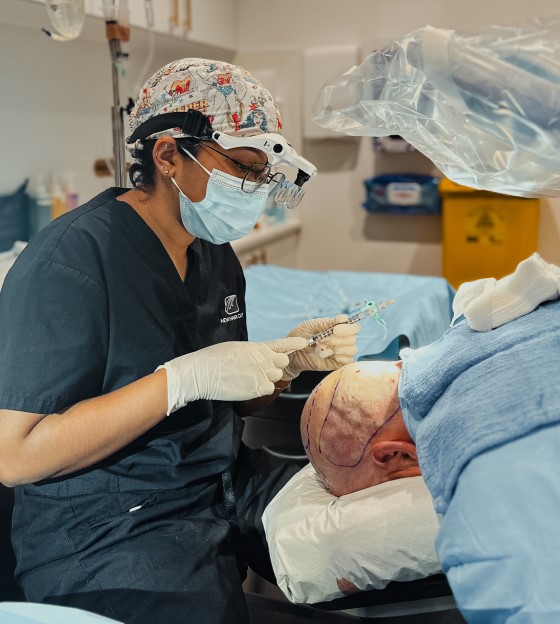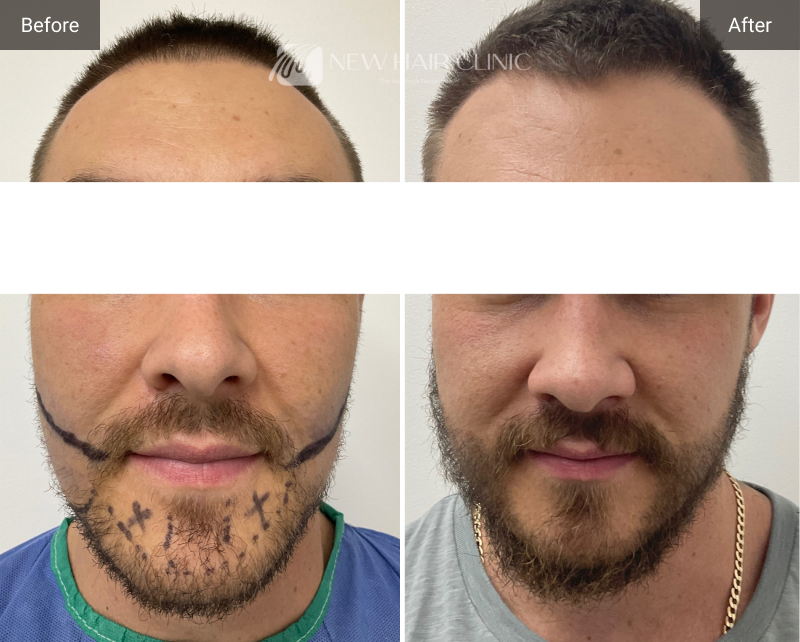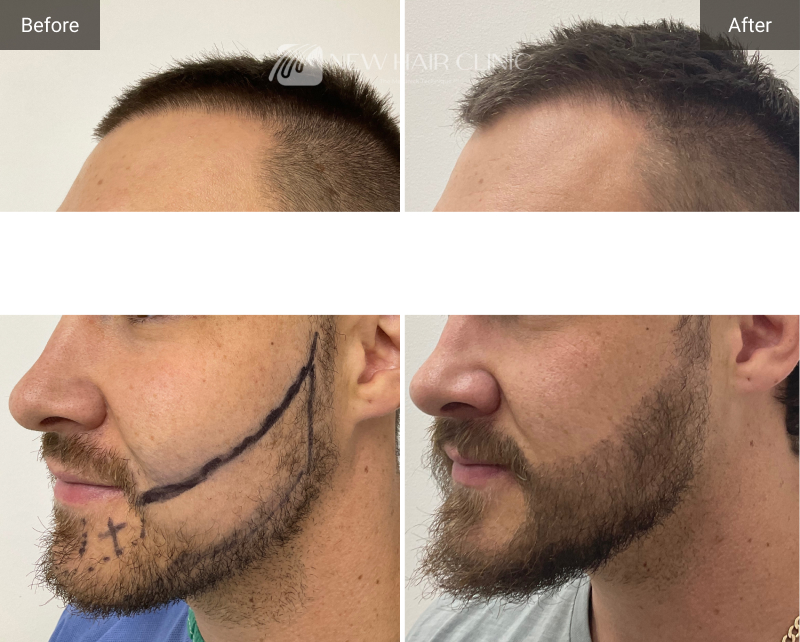90,000+ HAIR TRANSPLANTS
OVER 30+ YEARS
MEET WITH A HAIR TRANSPLANT
DOCTOR, NOT A SALES PERSON!
ONLY FULLY DOCTOR OWNED AND LED HAIR TRANSPLANT CLINIC IN AUSTRALIA
For Fuller, More Even Facial Hair
A beard transplant offers a permanent solution for men seeking to enhance their facial appearance and achieve a more full beard. Whether you desire a thicker, more uniform beard, or wish to camouflage patchy or uneven growth, beard and moustache transplants can help you achieve more natural, full facial hair.
With natural-looking results and minimal downtime, a beard transplant in Perth from New Hair Clinic is a safe and effective option for men of all ages.
What Can A Beard Transplants Treat?
Beard transplant procedures are designed to address a variety of concerns related to facial hair, including:
Patchy Beard
Many men struggle with patchy or uneven facial hair growth, which can affect their confidence and self-esteem. A beard transplant can fill in these sparse areas, creating a fuller and more uniform beard.
Uneven Growth
Some individuals may experience uneven growth patterns in their beard, with certain areas being thicker or sparser than others. A beard transplant can help to balance out these inconsistencies, resulting in a more symmetrical appearance.
Sparse Beard
Genetics, age, and hormonal factors can contribute to a sparse or thin beard. A beard transplant can add density and volume to the beard, giving it a thicker and more robust appearance.
Scar Revision
Scars from trauma, acne, surgery, or other injuries can disrupt the natural growth of facial hair, leading to bald patches or irregularities in the beard. A beard transplant can help to camouflage these scars by transplanting hair follicles into the affected areas.
Facial Hair Loss
Some individuals may experience facial hair loss due to medical conditions, such as alopecia areata, or as a side effect of certain medications or treatments. A beard transplant can restore lost facial hair and improve overall facial aesthetics.Overall, a beard transplant procedure offers a permanent solution for men seeking to enhance their facial appearance and achieve a fuller, more natural-looking beard. Whether you desire a subtle enhancement or a dramatic transformation, a beard transplant can help you achieve the facial hair you’ve always desired.
Wondering if Beard Transplant is
Right For You? Find Out Today

What Is A Beard Transplant?
A beard or moustache transplant is a surgical procedure that involves extracting healthy donor hairs from another site, typically the back of the head, and transplanting them to the beard area of the face. This procedure is performed under local anaesthesia to ensure patient comfort.
The implanted hairs are meticulously implanted into the beard area to create natural-looking growth. The goal of a beard transplant is to enhance facial appearance by filling in patchy or uneven areas and achieving a fuller, more uniform beard.
Benefits Of Beard Transplants
- Enhanced Facial Appearance: Beard implants can provide a fuller and more defined beard, improving overall facial aesthetics and symmetry.
- Permanent Solution: unlike temporary solutions such as topical treatments or makeup, beard transplants are a permanent solution for patchy or sparse facial hair.
- Natural-Looking Results: with advanced techniques like Follicular Unit Extraction (FUE), beard transplants deliver natural-looking new facial hair that seamlessly blend with existing beard growth.
- Minimal Downtime: recovery from beard transplants is typically quick, with most individuals able to resume normal activities within a few days post-procedure, allowing for a swift return to daily life.
- Fully Doctor-Led Experience: from consultation to procedure and follow-up, our doctor-only consultations ensure a comprehensive medical assessment to determine your eligibility for the procedure. Our skilled doctor can diagnose underlying medical conditions that may prevent a lasting procedure or compromise future hair restoration procedures.
Led by Dr. Wee, our clinic offers unparalleled expertise in beard transplants and hair restoration. With a commitment to patient-centric care, we prioritise your safety and satisfaction throughout the process.
Who Is A Good Candidate For Beard Transplant Procedure?
Ideal candidates for a facial hair transplant procedure include men who:
- Desire a fuller, more even beard
- Have sufficient donor hair for a transplant
- Are in good overall health with realistic expectations
- Are committed to following post-operative care instructions
Why Choose Us For Your Beard Transplant?
With over 25 years of experience correcting patchy beards and facial hair, New Hair Clinic is one of the most experienced hair loss clinics in Australia. Led by our highly skilled and experienced hair doctor, we specialise in beard transplant procedures that restore fullness and symmetry to your facial hair.
The journey to fuller beard hair growth with a beard diagnosis consultation with our doctor, either in-clinic or online. Book your consultation today to take the next step towards your dream beard.

What Is The Cost Of A Beard
Transplant In Perth?
If you’re tired of using various beard oils, serums, and grooming techniques that offer temporary fixes or don’t provide the natural-looking results you want, you may be wondering about the cost of a beard transplant in Perth, or other hair loss treatments for your beard aimed at regrowing hairs permanently. While we’d love to provide a specific figure, beard restoration is unique to each individual, and the cost can vary depending on your needs. Book a one-on-one consultation with one of our doctors to get the right information for your hair loss.
Depending on your diagnosis, the doctors at New Hair Clinic have a number of beard restoration options available. Instead of providing a one-size-fits-all answer here, we encourage you to book a personal consultation, free of any obligation. If that’s not convenient, feel free to call our friendly team on (08) 9389 6000, and we’ll be happy to answer any questions you have about beard transplant costs.
- Number of Grafts: 1,000+
- Number of Hairs: 2,500+
- Value From: $7,500
- Payment plans with TLC approx*: $55/week
- Number of Grafts: 2,000+
- Number of Hairs: 5,000+
- Value From: $12,500
- Payment plans with TLC approx*: $75/week
- Number of Grafts: 3,000+
- Number of Hairs: 7,500+
- Value From: $14,500
- Payment plans with TLC approx*: $85/week
- Number of Grafts: 4,000+
- Number of Hairs: Donor dependent+
- Value From: Consult required
The Treatment Process
Consultation
At New Hair Clinic, you’ll consult directly with our doctor, not a salesperson. Your consultation will be thorough and informative, allowing you to make an informed decision about your beard transplant procedure. During your facial hair transplant consultation, our doctor will assess your beard concerns, discuss your goals, and determine your eligibility for the procedure.
Procedure
On the day of your procedure, you’ll receive local anaesthesia to ensure your comfort. Our experienced doctor will extract hair follicles from the donor area (this will be your own hair) and implant them into the beard area with precision.
Recovery
Following your procedure, you may experience some swelling and minor discomfort around the new beard hairs, which can be managed with prescribed medications. Most patients can resume their normal activities within a few days, with full recovery typically occurring within a few weeks.
Results
Over the coming months, you’ll notice gradual hair growth in the transplanted beard area. Generally, transplanted hairs will fall within the first few weeks following a beard transplant procedure. This shedding is a normal part of the hair growth cycle and does not indicate a failed procedure. By around 6-12 months post-procedure when the transplanted hairs have settled, you’ll enjoy permanent, natural-looking beard growth.
Frequently Asked Questions
What is a Beard Hair Transplant?
A beard hair transplant involves extracting healthy hair follicles from a donor area and transplanting them to the beard area of the face, creating fuller, more even facial hair.
How do I prepare for a beard transplant procedure?
Prior to undergoing a beard transplant procedure, your hair transplant doctor will provide you with specific pre-operative instructions. These may include avoiding certain medications, refraining from smoking and following a healthy diet to optimise healing and recovery.
Are there any restrictions on grooming or styling after a beard transplant?
While it is important to follow your doctor’s post-operative care instructions, there are generally no long-term restrictions on grooming or styling your beard after a transplant. However, it is advisable to avoid aggressive grooming practices, such as shaving ortrimming, during the initial healing phase to protect the transplanted hairs.
Is a Beard Transplant Procedure Painful?
The procedure is performed under local anaesthesia, ensuring minimal discomfort. Some swelling and minor discomfort may occur during the recovery period, but this is temporary and can be managed with medication.
Are there any risks or complications associated with beard transplant surgery?
Like any surgical procedure, beard transplant surgery carries some risks, including infection, swelling, bleeding, and scarring. However, these risks are minimal when the procedure is performed by a qualified and experienced hair transplant doctor in a reputable clinic.
How do I find the best clinic for a beard transplant?
When seeking a clinic for a beard transplant procedure, it is essential to research and choose a reputable clinic with experienced hair transplant doctors. At New Hair Clinic, we specialise in facial hair transplants, have a track record of successful procedures, and prioritise patient safety and satisfaction.
Ask Us a Question
Got a question? Want to book a consultation? You’re in the right place. Fill out the form and one of our specialists will be in touch soon. Prefer a phone call? Perfect, give us a call on (08) 9389 6000.




